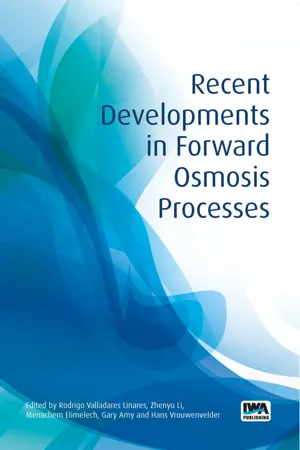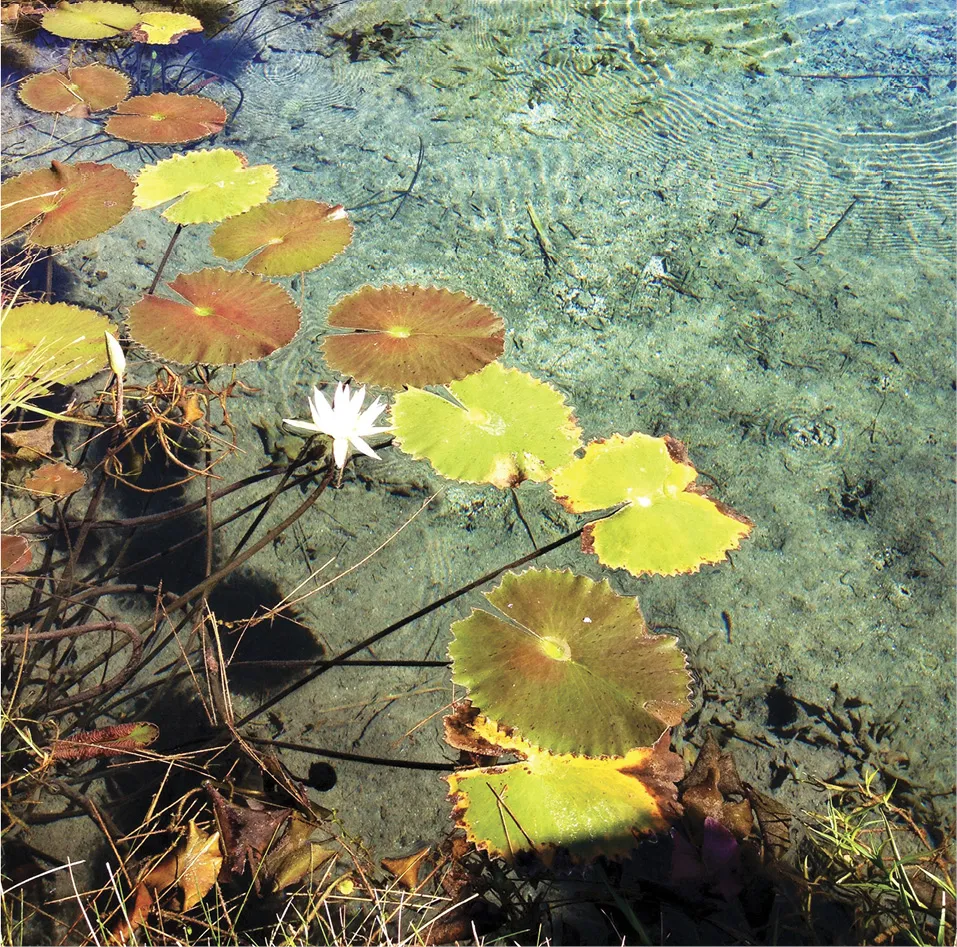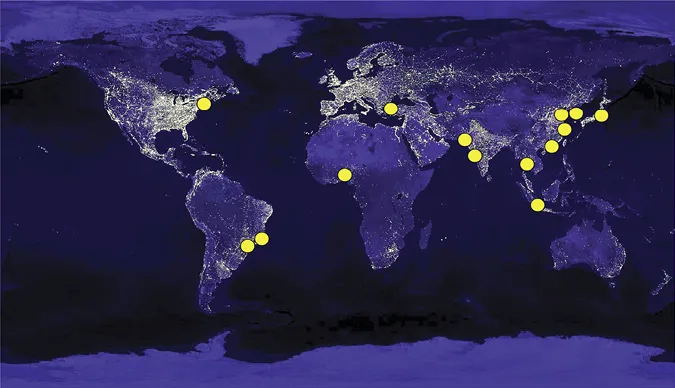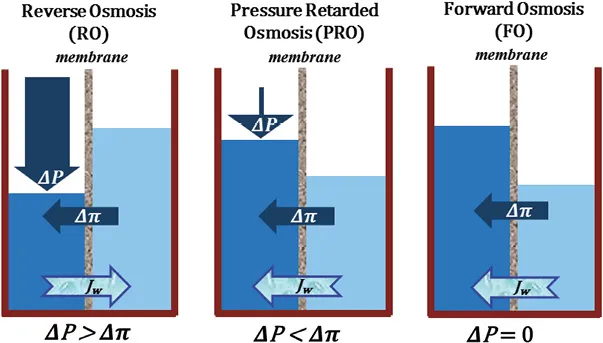
eBook - ePub
Recent Developments in Forward Osmosis Processes
- English
- ePUB (mobile friendly)
- Available on iOS & Android
eBook - ePub
Recent Developments in Forward Osmosis Processes
About this book
Forward osmosis (FO) is an emerging membrane technology with a range of possible water treatment applications (desalination and wastewater treatment and recovery).
Recent Developments in Forward Osmosis Processes provides an overview of applications, advantages, challenges, costs and current knowledge gaps. Commercial technology, hybrid FO systems for both desalination and water recovery applications have shown to have higher capital cost compared to conventional technologies. Nevertheless, due to the demonstrated lower operational costs of hybrid FO systems, the unit cost for each m3 of fresh water produced with the FO system are lower than conventional desalination/water recovery technologies (i.e. ultrafiltration/RO systems).
There are key benefits of using FO hybrid systems compared to RO:
• chemical storage and feed systems may be reduced for capital, operational and maintenance cost savings,
• reduced process piping costs,
• more flexible treatment units,
• higher overall sustainability of the desalination process, while producing high quality water.
Frequently asked questions
Yes, you can cancel anytime from the Subscription tab in your account settings on the Perlego website. Your subscription will stay active until the end of your current billing period. Learn how to cancel your subscription.
No, books cannot be downloaded as external files, such as PDFs, for use outside of Perlego. However, you can download books within the Perlego app for offline reading on mobile or tablet. Learn more here.
Perlego offers two plans: Essential and Complete
- Essential is ideal for learners and professionals who enjoy exploring a wide range of subjects. Access the Essential Library with 800,000+ trusted titles and best-sellers across business, personal growth, and the humanities. Includes unlimited reading time and Standard Read Aloud voice.
- Complete: Perfect for advanced learners and researchers needing full, unrestricted access. Unlock 1.4M+ books across hundreds of subjects, including academic and specialized titles. The Complete Plan also includes advanced features like Premium Read Aloud and Research Assistant.
We are an online textbook subscription service, where you can get access to an entire online library for less than the price of a single book per month. With over 1 million books across 1000+ topics, we’ve got you covered! Learn more here.
Look out for the read-aloud symbol on your next book to see if you can listen to it. The read-aloud tool reads text aloud for you, highlighting the text as it is being read. You can pause it, speed it up and slow it down. Learn more here.
Yes! You can use the Perlego app on both iOS or Android devices to read anytime, anywhere — even offline. Perfect for commutes or when you’re on the go.
Please note we cannot support devices running on iOS 13 and Android 7 or earlier. Learn more about using the app.
Please note we cannot support devices running on iOS 13 and Android 7 or earlier. Learn more about using the app.
Yes, you can access Recent Developments in Forward Osmosis Processes by Rodrigo Valladares Linares,Zhenyu Li,Menachem Elimelech,Gary Amy,Hans Vrouwenvelder in PDF and/or ePUB format, as well as other popular books in Biological Sciences & Applied Sciences. We have over one million books available in our catalogue for you to explore.
Information
© IWA Publishing 2017. Rodrigo Valladares Linares, Zhenyu Li, Menachem Elimelech, Gary Amy and Hans Vrouwenvelder. Recent Developments in Forward Osmosis Processes. DOI: 10.2166/9781780408125_001
Part 1
Introduction
Introduction

Chapter 1.1
Population distribution and water scarcity
Globally, the level of urbanization has significantly increased during the last six decades. In 2010, urban areas comprised 3.5 billion people, or 50.5 per cent of the world’s population (United Nations, 2011). Due to the development of coastal regions in many countries, two-fifths of cities with populations of 1 million to 10 million people are located near coastlines (Tibbetts, 2002). Moreover, 14 of the largest 17 cities in the world are situated along coasts (Figure 1.1.1) (Creel, 2003b).

Figure 1.1.1 Fourteen of the world’s largest cities are located along the coast (indicated in orange), which translates into an opportunity to integrate drinking water and wastewater management, especially in water-stressed areas (Creel, 2003) (image adapted from: NASA (2000)).
With increasing population growth, the demand for clean water is also increasing. Under an average economic growth scenario and when no efficiency gains are assumed, global fresh water demand will increase 53% from 2009 to 2030, from 4.5 trillion m3 to 6.9 trillion m3 (The Barila Group et al. 2009), with a proportionally greater deficit in many developing countries. This situation will leave between 2.4 billion and 3.2 billion people under water-scarce or water-stressed conditions by year 2025, four-folding the number of people that lived in areas with limited fresh water availability at the beginning of the 20th century. Water shortage is likely to grow especially acute in the Middle East and much of Africa (Engelman et al. 2000), as well as vast areas in Australia, China, India and Mexico (Figure 1.1.2), directly associated with the physical absence of additional fresh water resources to cover their demand. Besides the amount of water itself, the quality must comply with the minimum standards set by each country’s regulations to be considered as potable; diarrheal disease alone is responsible for the death of 1.8 million people every year, and it was estimated that 88% of these cases are attributable to unsafe water supply, sanitation and hygiene (Prüss-Üstün & Corvalá, 2004).

Figure 1.1.2 Projected global water scarcity by 2025 (international water management institute).
Human population distribution along the coasts represents a great challenge in terms of water management, due to the contamination of surface and ground water (basins, aquifers, rivers, etc.), limited fresh water sources in some areas, and more stringent environmental regulations that restrict the use of certain water resources. Therefore, a comprehensive strategy for the management of water resources is crucial for the sustainable development of these areas (Li et al. 2014).
Since more than 97% of the water in the world is seawater (Figure 1.1.3), desalination technologies have the potential to solve the fresh water crisis, particularly in coastal areas. The most used desalination technique nowadays is reverse osmosis, where a membrane is used as a physical barrier to separate the salts from the water, using high hydraulic pressure (Amjad, 1993). Nevertheless, the use of pressure imposes a high cost on operation of these systems, besides the known persistent fouling problems associated with membrane filtration systems (Ridgway & Flemming, 1996; Shannon et al. 2008; Vrouwenvelder et al. 2008).

Figure 1.1.3 Total water distribution in the world (UNESCO, 1999).
Research has identified the potential for hybrid forward osmosis/reverse osmosis (FO/RO) systems for several applications, including sweater desalination (Choi et al. 2009), to reduce the cost and fouling propensity of producing fresh water from impaired-quality water sources (Chang et al. 2002; Achilli et al. 2009; Boo et al. 2013). Recently, studies have shown the potential of these systems to produce low cost high quality fresh water using low pressure desalination, while simultaneously recovering impaired water from a recycled feed water (Cath et al. 2009; Yangali-Quintanilla et al. 2011). Nevertheless, there are concerns about the use of FO membranes as a barrier for rejecting micropollutants and nutrients from the wastewater, besides the inevitable fouling problems that can occur during the filtration process, when the membrane is submerged in the recycled feed water, resulting in a poor water flux and an increase in the operational cost due to membrane cleaning.
1.1.1 OSMOTIC MEMBRANE PROCESSES
Osmosis is defined as the transport of water through a semipermeable membrane caused by a difference in osmotic pressure for the solutions on both sides of the membrane. The osmotic pressure is related to the concentration of dissolved ions in solution and the temperature (Cath et al. 2009).
Osmotic pressure (π) can be calculated using the van’t Hoff equation (van’t Hoff, 1887):
 | (1.1.1) |
where i is the dimensionless van’t Hoff factor for the specific ion, M is the molarity of the specific ion, R is the gas constant (0.08206 L ⋅ atm ⋅ mol−1 ⋅ K−1), and T is the temperature in Kelvin.
The most common applied membrane filtration processes are reverse osmosis (RO), pressure retarded osmosis (PRO) and forward osmosis (FO), also known as osmosis or direct osmosis, are shown in Figure 1.1.4.

Figure 1.1.4 Osmotic processes in membrane filtration. ΔP – applied hydraulic pressure; Δπ – osmotic pressure difference between the two solutions; Jw – water flux.
RO occurs when the osmotic pres...
Table of contents
- Cover
- Half Title
- Title Page
- Copyright Page
- Contents
- Additional Image credits
- List of Contributors
- Preface
- Summary
- Part 1: Introduction
- Part 2: Water Recovery
- Part 3: Fouling
- Part 4: Rejection of Pollutants
- Part 5: Draw Solution and Membranes
- Part 6: Modeling
- Part 7: Outlook
- Supplementary material
- Index